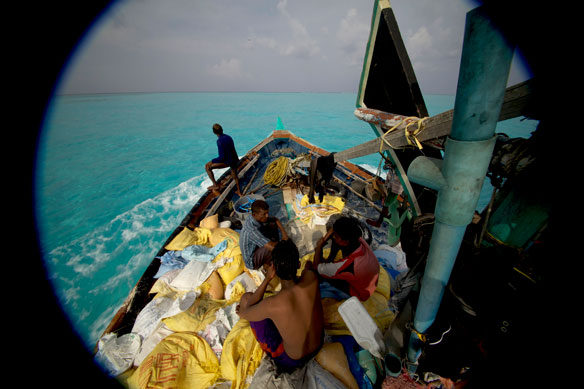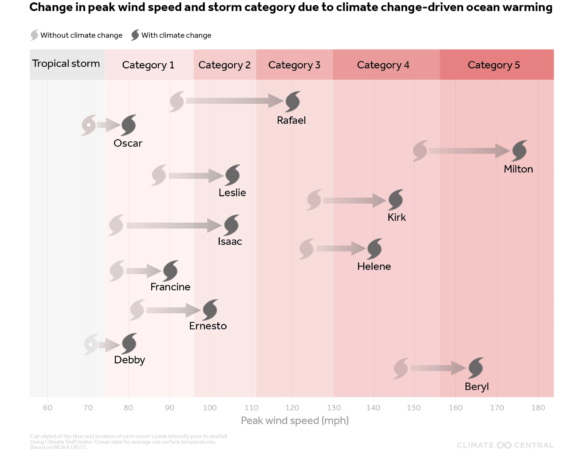
Beach sand mining, Maldives. Photo courtesy of: © Denis Delestrac
“Zandoorlog,” by Peter Dupont;
Article originally published in Dutch, in the Octobrer edition of the Belgian magazine EOS. Translation by Rafael Njotea.
Sand is the new gold. The worldwide excavation of sand on beaches and in rivers and oceans is signalling an ecological and human catastrophe.
A worldwide sand rush is taking place. Sand is bagged by divers on the Maldives, it is towed from beaches to trucks by mules in Morocco, excavated from heavenly beaches by machines in the Philippines. In Indonesia dredge boats suck it up from the bottom of the sea, in Vietnam from the river Con. In Sierra Leone workers excavate every grain from local beaches, while on the other side of the Atlantic, in the Caribbean, sand thieves steal entire beaches unnoticed. Google Earth leaves nothing to the imagination.
The rising sea level devours more and more beaches and sand as well. This is a worrying observation, if we take into account the fact that forty percent of the world population lives within just one hundred kilometres of a shoreline. Governments everywhere are having the impact of global warming on their shores assessed. Only recently, results were published of a research study on the vulnerability of the French sand shores.
What is striking is that amidst all the research being conducted, and even though a proper sand war is being fought on the planet, there is hardly any mention of the disturbing consumption of sand. While water, oil and land crises attract attention easily, the sand crisis is largely being ignored.
Essential Raw Material
Sand is the most wanted raw material on the planet. During the past century and a half it has quietly won a spot in all aspects of our lives. In his book ‘Sand: The Never-Ending Story’ British geologist and sand expert Michael Welland describes sand as an ‘unappreciated hero’. Man has become addicted to sand, says Welland. There is sand in every glass bottle, in the mineral silicon dioxide, which can be found in wine and cleaning products. There is sand in paper, in dried food, detergents, cosmetics, hair spray, toothpaste and a whole range of other products that we use every day. Without sand there would be no microchips, no computer, no mobile phone, no credit card, no ID card. Without sand the 21st century as we know it would not exist. Modern-day information society would be impossible without minerals extracted from sand, like titanium, magnetite, gypsum crystals, uranium and even gold.
But above all, sand is a key raw material for the construction business. Building requires tons of sand. Armoured concrete is two-thirds sand. The construction of a house costs on average two hundred tons of sand. Thirty thousand tons are needed for a one-kilometre stretch of motorway; twelve million tons for a nuclear plant. After water, sand is the most-used material in the world. According to British environment specialist Kiran Pereira, more than fifteen billion tons of sand are consumed on the planet per year.
And the demand for sand keeps rising, crisis or no crisis. Fast growing countries such as China, Brazil, India and rich Arab countries like Dubai have set their sights on sand. But also in other countries the demand for sand is soaring, primarily in construction. Especially near coasts. The growing world population pushes more and more people to the coast. Land reclamation and coastal management have become booming business. Unsurprisingly, the global trade in sand yields 70 billion dollars every year.
However, sand supplies are limited. Old sand quarries are empty, new ones are destroying the landscape. Sand winning from rivers leads to floods and ecological dramas. Biodiversity is going down with it. Rivers are finding other beds, shores are collapsing, bridges are destroyed, species are vanishing. It is impossible to work out exactly how much damage sand excavation does to nature and the environment.
At one point the idea was to get our sand from the desert. It was short-lived: desert sand is worthless. That is why sand is increasingly dredged from oceans. A large part of the ocean floor is covered with a thin layer of sand that has gathered there for the past ten thousand years. Thousands of dredge boats are now shovelling up that free sand, leaving the ocean floors and riverbeds empty. But that story, too, will come to an end. The sand ships’ impact on marine ecology, coastline and fish is enormous. Unfortunately, it has never been calculated on a meta-level.
Ecological Time Bomb
Everywhere in the world beaches, historical barriers against seawater, are being sacrificed to sustain the construction mania, the hunger for land reclamation and other human ‘needs’. On the Maldives, the 1,200 islet archipelago in the Indian Ocean, the excavation of sand from coral reefs and lagoons for the construction of tourist infrastructure has led to the disappearance of several beaches. Many islands have been evacuated; environmental refugees were received on other islands. That, of course, means new buildings, which means more sand. Despite the general fear that almost all of the two hundred inhabitable islands will have to be evacuated by 2100, the excavation continues. The Maldives are literally digging their own grave.
A similar story is playing in many other places on the planet. Wherever possible, sand is excavated, traded, smuggled, raided and stolen. Because of sand, whole ecosystems and coasts are lost, ocean floors, river beds and beaches are plundered. It is an ecological time bomb: the rising sea level on the on hand, disappearing beaches on the other.
Especially in Asia, with its many fast-growing countries and huge population explosion, the sand war is raging. A quarter of sand consumption happens on China’s account. But Singapore, too, uses up a lot. The small island nation saw its landmass grow by twenty percent over the past thirty years, through land reclamation on sea. It was helped solely by a few Flemish and Dutch big-time dredging and land reclamation companies: the Flemish DEME and De Nul and their Dutch competitors Royal Boskalis Westminster and Van Oord. No fewer than 132 square kilometres of sea were made into land in Singapore. By 2030 another hundred square kilometres should be transformed. In other words, the demand for sand is gigantic, not just for the reclamation itself, but also for the construction of new buildings and roads.
Dredging
Because Singapore has used up its own raw materials and has mined away its hills, it is looking for sand in neighbouring countries. The resulting export prohibition for sand in Vietnam, Indonesia and Cambodia – because of the huge ecological impact – triggered large-scale sand smuggling in Indonesia, Malaysia and the Philippines a while ago. Sand thieves are stealing entire beaches, thereby jeopardising the survival of dozens of islands in the region. Environmental watchdog Global Witness sounded the alarm in 2010 with its report ‘Shifting Sand’, in which it says that, in addition to the ecological damage done, the import of illegal sand from Cambodia has also created a culture of greed and corruption in the country.
In the report the organisation criticises Singapore, which still refuses to make public the origin of its imported sand, as well as the dredging industry, who, according to Global Witness, build up a green image for themselves while leaving an enormous ecological burden on the planet. Without blinking they are doing in Asia that which they cannot do in the US or Europe.
Singaporean marine biologist Chou Loke Ming (Biological Science Center of the National Institute of Singapore) says what the dredging industry wants to ignore. Together with the ocean floor sand the dredge boats suck up flora and fauna. The impact on the water ecology is disastrous. It destroys coral reefs and decimates fish stocks, which is the de facto end of many fishing communities.
Sand winning around islands also has a large impact on the islands themselves. An island is the product of several natural processes: sand, water, wind and currents. The extraction of sand disturbs the balance and waves, gravity and currents start shifting the sand under the beaches. That could mean the end of an island. Indonesia has seen dozens of islets disappear in the waves that way. In the Northern Philippine coastal towns of Caoayan and San Vincente, on the island of Luzon, the South China Sea has recently begun cutting deep trenches through the beaches. The inhabitants can expect the sea to enter their homes in the near future. In front of the coast, huge sand ships are sucking away their natural line of protection. On the beach, the sand is being excavated meters-deep.
Sand Mafia
Dwindling sand supplies, rising prices and an increased demand have given rise to a sand mafia. In many countries criminals collaborates closely with corrupt governments and police. In over 8,000 places in India, for example, sand is exploited illegally. Forty percent of Morocco’s sand trade involves illegal sand that is excavated and immediately sold on construction sites. There, it is used unprocessed to make concrete, a guarantee for future problems. The Moroccan government fears that most of its country’s beaches are being transformed into a moonscape.
Mother Nature has its own way to counter coastal erosion via a natural supply of sand. Most beach sand comes from rivers that bring it in from the mountains. But exactly these rivers are being dammed up. That effectively stops the migration of sand. Worldwide, almost 850,000 dams are stopping the supply of fresh sand and are holding up one quarter of the sand supplies. River dredging is another cause why half the sand that would normally reach the sea doesn’t succeed in doing that.
Most beaches on our planet have a minor chance of survival. A new, simpler way of life seems to be the only remedy against the consumption of sand. But that is not a realistic remedy. The race for raw materials has started all around the world.
Soon, it will be allowed to exploit international seabeds and ocean floors, too. The International Seabed Authority has already given the go-ahead. This independent organisation, founded in the heart of the United Nations, manages and controls seabed excavation in international waters. At this point, companies can only buy dredging rights for mineral-rich sites. From 2016 onwards they would be able to apply for licenses to actually exploit the bottom of the sea.
Even though biologists think deep sea mining is madness – it’s impossible to assess the impact – it will without doubt instigate a new rush for gold and other precious minerals. In that scenario sand, however deep under water, is quickly put into the mix as well. The discovery of big sand dunes deep under the South China Sea – for one – begs for a more advanced trailing suction hopper dredger head… The raw material war has only just begun.
Sand Wars Movie: Environment Award 2014 Winner At The 11th Annual San Francisco International Ocean Film Festival
The San Francisco International Ocean Film Festival has announced the 10 awards winners of its 11th Annual Festival, and conferred the Environment Award to Denis Delestrac Documentary Film: Sand Wars.
Let’s Talk About Sand: Denis Delestrac At TEDxBarcelona
Denis Delestrac latest feature documentary, “Sand Wars” is an epic eco-thriller that takes the audience around the globe to unveil a new gold rush and a disturbing fact: we are running out of sand! In this TEDxBarcelona talk, he explains us where sand comes from and where it ends up…








